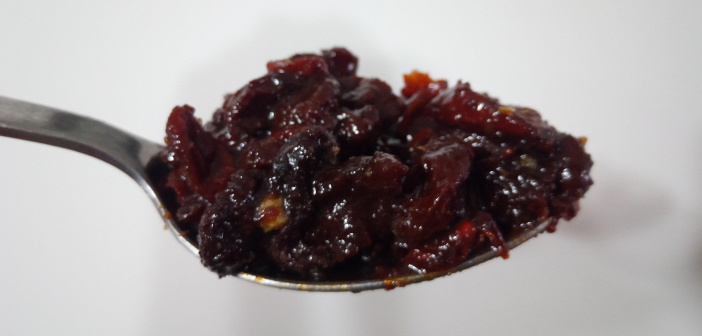Having successfully made candied peel, my quest to make traditional Christmas mince pies using ingredients available in China took me on to the greatest challenge: the mincemeat itself.
Despite the name, mincemeat contains no meat. The name reflects the fact it was originally a mixture of mutton or beef with dried fruit and wine or vinegar. By the 20th century though, the meat had been dropped and the pie became a Christmas dessert sweetened with sugar and livened up with brandy. While I had no intention of going so vintage as to include meat in my pies, there is one animal ingredient which is virtually essential: suet.
Suet is the hard fat from around an animal’s kidneys. This may not sound like something you would associate with desserts, but in fact it has a long history of being used in puddings in the British isles, with the fat acting to bind together the other ingredients. (And those who balk at the idea of animal fat in their dessert often have no problem with the presence of gelatin.)
You can get suet imported from the UK on Taobao, albeit expensively. But this would be cheating, and besides, if ordered now it wouldn’t arrive in time for Christmas. So I set off to the supermarket, to try my luck.
According to Pleco the Chinese for suet is 板油, bǎn yóu. Armed with this information I set out for my local supermarket. The assistant in the oil section saw me coming and scarpered for the store room before she was forced to converse with the laowai. So I sneaked up on a second one, and waved my phone at her before she could escape. She took me in search of her missing colleague, who stayed missing, and eventually strode off leaving me waiting amid the oils. A third pointed me to the meat counter.
But my request for bǎn yóu met with hand shakes and “méi yǒu” (in this context meaning roughly “no chance, mate”.) Even simple “zhū yóu”, basic pork fat, was not available. Given the amount of pork farmed and consumed in China, I pondered, where does all the fat go?
So I gave up and decided to use butter instead. Butter works perfectly well to bind the ingredients, but means the mincemeat can’t be stored and used next year. (Yes, you read that right. Mincemeat developed as a way of preserving meat and fruit, and keeps for an incredibly long time. In fact, after a year it tastes even better.)
So here’s my recipe for China-friendly mincemeat:
First, you’ll need a couple of apples. British recipes call for Bramleys, which are sour cooking apples. I just used these green apples from the supermarket.

The main ingredient is dried fruit. To be honest I’ve never really understood the difference between raisins, currants, and sultanas, but I found three different kinds of what appear to be dried grapes. About 250g of each will do the job.
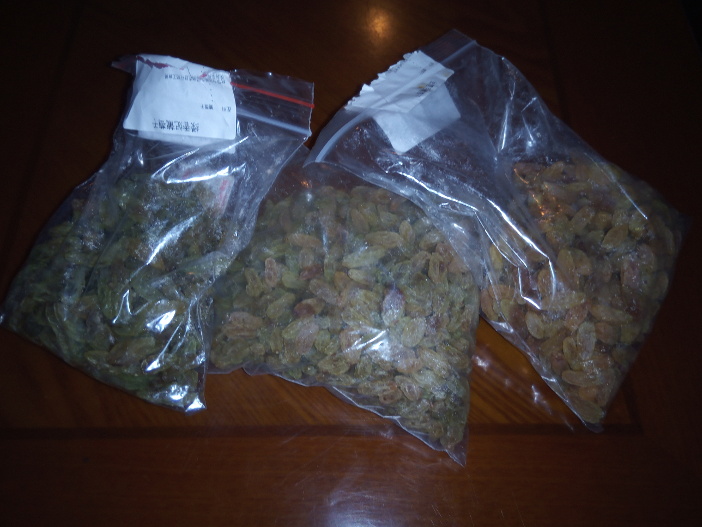
Raisins, currants, and sultanas. Or possibly currants, sultanas, and raisins. Dried grapes anyway.
The great thing about mincemeat is that it’s one of those “whatever you have lying around” recipes. I added some dried cranberries, and, for a touch of the exotic, dried goji berries.
Finely chop the apple, and mix it with the dried fruit. Then stir 200g of soft brown sugar into 200ml of brandy. (Some recipes suggest measuring the brandy in tablespoons. These people are deeply wrong. Glug it in, with a free hand.)
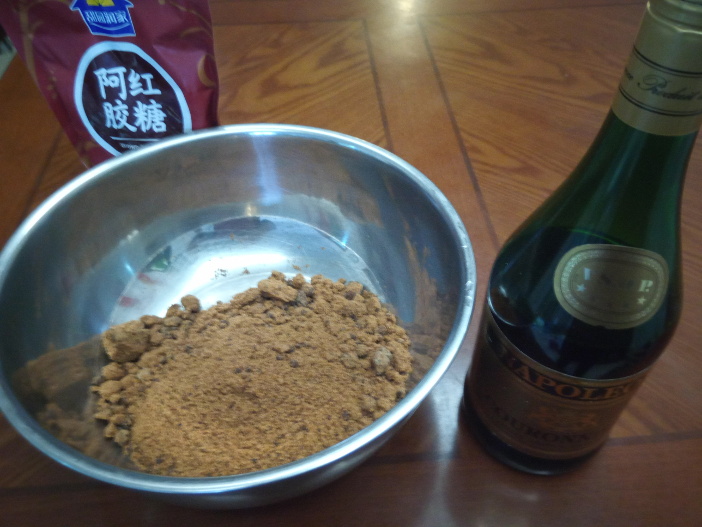
Brandy and brown sugar. What’s not to like?
When the sugar is dissolved in the brandy as much as possible, pour the brandy into the dried fruit and apple mixture. Mix it up well, cover, and leave overnight, so the fruit soaks up the brandy.
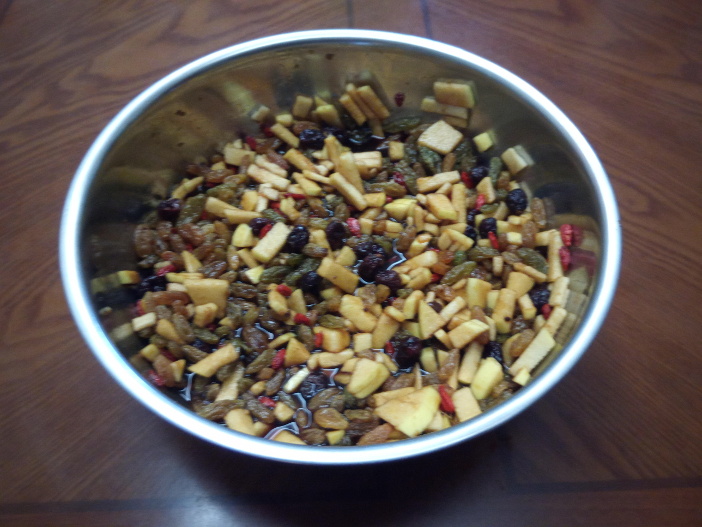
Returning to your mixture the next day, you should find the fruit is now plump and juicy with sweet, sweet brandy. It’s time to add everything else: spices, nuts, lemon zest, your homemade candied peel, and the all-important fat. Nutmeg is not easily available here, so in the end I grated a cinnamon stick to add some zip, and chopped up some almonds.
The butter was more of a challenge. I put it in the freezer for a while, then chopped it fine, and stirred it into the mixture. This I left overnight once more, in the somewhat optimistic hope that the butter would melt in. But the next day, there were still lumps of butter visible. My only option was to cook the mixture.
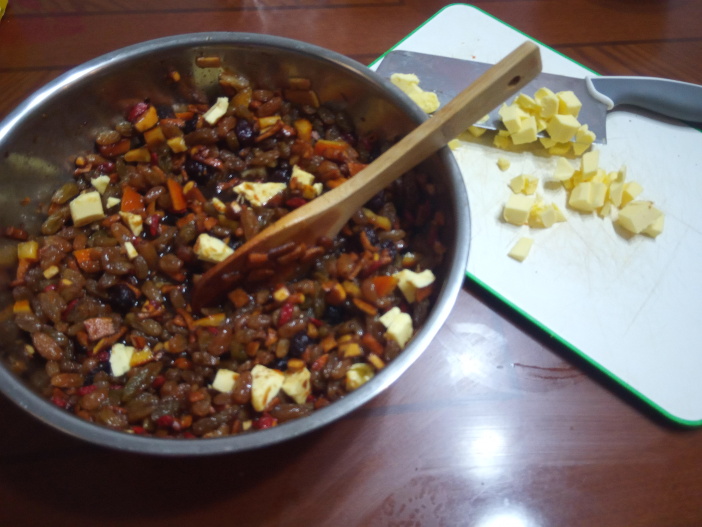
Adding the butter
Opinion is divided on whether mincemeat should be cooked, and in the past I have been adamant that leaving it to stand for a few weeks does the job better. But with no time before Christmas, I was forced to set the oven on its lowest heat, cover the pot and let it warm through for three hours. The results were a huge relief: my mixture now not only looked like mincemeat, but smelt like it too, permeating the apartment with a Christmassy odor of spices and brandy.
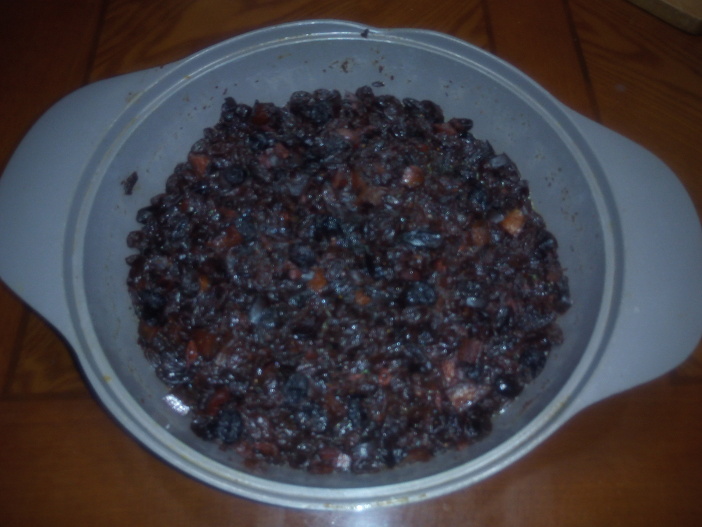
Look! It worked!
Next: the pies.
Photos: Andrew Killeen

